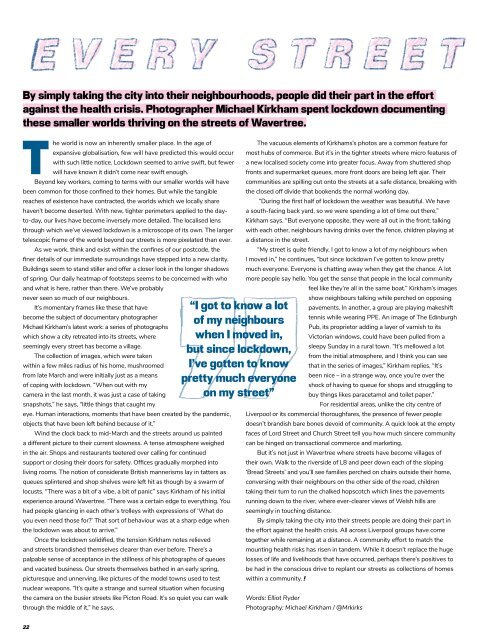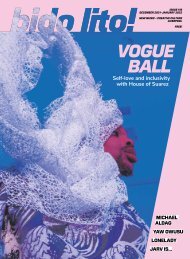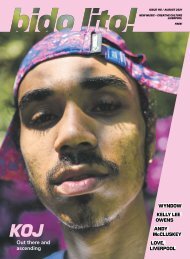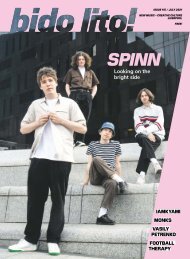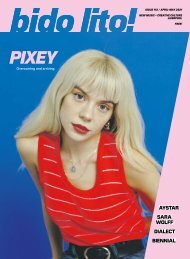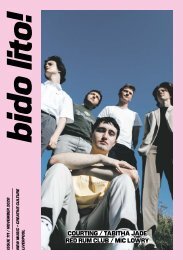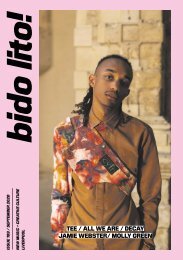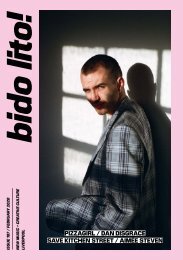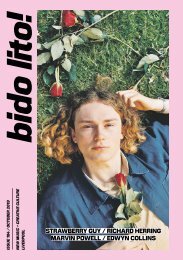Lockdown Zine / July 2020
Special edition Lockdown Zine issue of Bido Lito! magazine. Featuring original writing, photography and illustration produced in the months of UK lockdown, 2020.
Special edition Lockdown Zine issue of Bido Lito! magazine. Featuring original writing, photography and illustration produced in the months of UK lockdown, 2020.
Create successful ePaper yourself
Turn your PDF publications into a flip-book with our unique Google optimized e-Paper software.
By simply taking the city into their neighbourhoods, people did their part in the effort<br />
against the health crisis. Photographer Michael Kirkham spent lockdown documenting<br />
these smaller worlds thriving on the streets of Wavertree.<br />
The world is now an inherently smaller place. In the age of<br />
expansive globalisation, few will have predicted this would occur<br />
with such little notice. <strong>Lockdown</strong> seemed to arrive swift, but fewer<br />
will have known it didn’t come near swift enough.<br />
Beyond key workers, coming to terms with our smaller worlds will have<br />
been common for those confined to their homes. But while the tangible<br />
reaches of existence have contracted, the worlds which we locally share<br />
haven’t become deserted. With new, tighter perimeters applied to the dayto-day,<br />
our lives have become inversely more detailed. The localised lens<br />
through which we’ve viewed lockdown is a microscope of its own. The larger<br />
telescopic frame of the world beyond our streets is more pixelated than ever.<br />
As we work, think and exist within the confines of our postcode, the<br />
finer details of our immediate surroundings have stepped into a new clarity.<br />
Buildings seem to stand stiller and offer a closer look in the longer shadows<br />
of spring. Our daily heatmap of footsteps seems to be concerned with who<br />
and what is here, rather than there. We’ve probably<br />
never seen so much of our neighbours.<br />
It’s momentary frames like these that have<br />
become the subject of documentary photographer<br />
Michael Kirkham’s latest work: a series of photographs<br />
which show a city retreated into its streets, where<br />
seemingly every street has become a village.<br />
The collection of images, which were taken<br />
within a few miles radius of his home, mushroomed<br />
from late March and were initially just as a means<br />
of coping with lockdown. “When out with my<br />
camera in the last month, it was just a case of taking<br />
snapshots,” he says, “little things that caught my<br />
eye. Human interactions, moments that have been created by the pandemic,<br />
objects that have been left behind because of it.”<br />
Wind the clock back to mid-March and the streets around us painted<br />
a different picture to their current slowness. A tense atmosphere weighed<br />
in the air. Shops and restaurants teetered over calling for continued<br />
support or closing their doors for safety. Offices gradually morphed into<br />
living rooms. The notion of considerate British mannerisms lay in tatters as<br />
queues splintered and shop shelves were left hit as though by a swarm of<br />
locusts. “There was a bit of a vibe, a bit of panic” says Kirkham of his initial<br />
experience around Wavertree. “There was a certain edge to everything. You<br />
had people glancing in each other’s trolleys with expressions of ‘What do<br />
you even need those for?’ That sort of behaviour was at a sharp edge when<br />
the lockdown was about to arrive.”<br />
Once the lockdown solidified, the tension Kirkham notes relieved<br />
and streets brandished themselves clearer than ever before. There’s a<br />
palpable sense of acceptance in the stillness of his photographs of queues<br />
and vacated business. Our streets themselves bathed in an early spring,<br />
picturesque and unnerving, like pictures of the model towns used to test<br />
nuclear weapons. “It’s quite a strange and surreal situation when focusing<br />
the camera on the busier streets like Picton Road. It’s so quiet you can walk<br />
through the middle of it,” he says.<br />
The vacuous elements of Kirkhams’s photos are a common feature for<br />
most hubs of commerce. But it’s in the tighter streets where micro features of<br />
a new localised society come into greater focus. Away from shuttered shop<br />
fronts and supermarket queues, more front doors are being left ajar. Their<br />
communities are spilling out onto the streets at a safe distance, breaking with<br />
the closed off divide that bookends the normal working day.<br />
“During the first half of lockdown the weather was beautiful. We have<br />
a south-facing back yard, so we were spending a lot of time out there,”<br />
Kirkham says. “But everyone opposite, they were all out in the front; talking<br />
with each other, neighbours having drinks over the fence, children playing at<br />
a distance in the street.<br />
“I got to know a lot<br />
of my neighbours<br />
when I moved in,<br />
but since lockdown,<br />
I’ve gotten to know<br />
pretty much everyone<br />
on my street”<br />
“My street is quite friendly. I got to know a lot of my neighbours when<br />
I moved in,” he continues, “but since lockdown I’ve gotten to know pretty<br />
much everyone. Everyone is chatting away when they get the chance. A lot<br />
more people say hello. You get the sense that people in the local community<br />
feel like they’re all in the same boat.” Kirkham’s images<br />
show neighbours talking while perched on opposing<br />
pavements. In another, a group are playing makeshift<br />
tennis while wearing PPE. An image of The Edinburgh<br />
Pub, its proprietor adding a layer of varnish to its<br />
Victorian windows, could have been pulled from a<br />
sleepy Sunday in a rural town. “It’s mellowed a lot<br />
from the initial atmosphere, and I think you can see<br />
that in the series of images,” Kirkham replies. “It’s<br />
been nice – in a strange way, once you’re over the<br />
shock of having to queue for shops and struggling to<br />
buy things likes paracetamol and toilet paper.”<br />
For residential areas, unlike the city centre of<br />
Liverpool or its commercial thoroughfares, the presence of fewer people<br />
doesn’t brandish bare bones devoid of community. A quick look at the empty<br />
faces of Lord Street and Church Street tell you how much sincere community<br />
can be hinged on transactional commerce and marketing.<br />
But it’s not just in Wavertree where streets have become villages of<br />
their own. Walk to the riverside of L8 and peer down each of the sloping<br />
‘Bread Streets’ and you’ll see families perched on chairs outside their home,<br />
conversing with their neighbours on the other side of the road, children<br />
taking their turn to run the chalked hopscotch which lines the pavements<br />
running down to the river, where ever-clearer views of Welsh hills are<br />
seemingly in touching distance.<br />
By simply taking the city into their streets people are doing their part in<br />
the effort against the health crisis. All across Liverpool groups have come<br />
together while remaining at a distance. A community effort to match the<br />
mounting health risks has risen in tandem. While it doesn’t replace the huge<br />
losses of life and livelihoods that have occurred, perhaps there’s positives to<br />
be had in the conscious drive to replant our streets as collections of homes<br />
within a community. !<br />
Words: Elliot Ryder<br />
Photography: Michael Kirkham / @Mrkirks<br />
22


